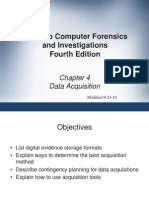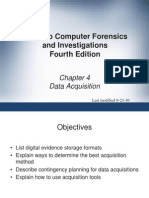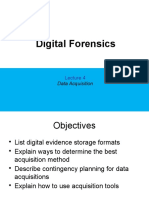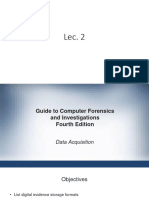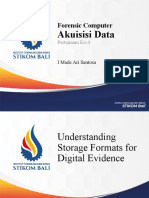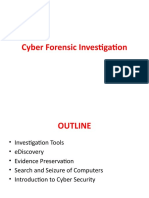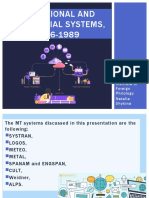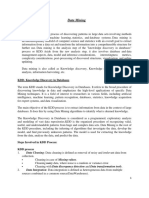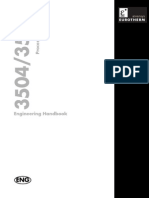Digital Forensics
Module 3
� Evidence Collection
Data Acquisition
• Data acquisition is the act of collecting data relevant to an
investigation
• It can be live data, including memory captures, or it can be collected
in a forensically sound manner as an image or a forensic copy
• The data acquisition should be conducted in a manner that creates
the fewest changes to a system
� Evidence Collection
Data Acquisition
• The acquisition of a system that is powered off is the simplest
example of collecting data in a forensically sound manner
• The analyst removes the system’s hard drive
• The hard drive is connected to the read-only port of a firmware write block
• A target device to store an image or a copy is connected to the read-write
port of the write block
• The communications port of the write block is connected to a computer or a
standalone device, or is built in
• The analyst then creates an image or a copy by writing to the target device
• The original is maintained and documented in a chain-of-custody form.
• The image or copy can then be examined (or additional copies made) on the
analysis platform
�Evidence Collection
Data Acquisition
� Evidence Collection
Data Acquisition
Live Data (Including Memory)
• Live data acquisition involves collecting data from a running system
• This can include memory, mounted files
• Such as Windows registry hives, unencrypted volumes or file systems,
security files, or open processes
• Live data acquisition has become common in cases where a suspect is
believed to have used full disk encryption
• Which means shutting down the system will remove the decryption
key from memory
� Evidence Collection
Data Acquisition
Live Data (Including Memory)
Files
• Acquisition of files or mounted volumes can be accomplished by using
software such as AccessData’s FTK Imager, Mandiant’s RedLine
• Acquiring files utilizing a forensic tool rather than the Copy command
provides better options for accountability of what was acquired
• Chain of custody documentation, and verification through hashing is
also possible
• It can allow for acquisition of files that are protected by the OS such
as Windows registry hives, the Master File Table, or other metadata
files
� Evidence Collection
Data Acquisition
Live Data (Including Memory)
Memory
• Memory can be acquired using software tools such as AccessData’s
FTKImager, Mandiant’s RedLine, or a memory dump tool such as LiME
• Memory is often acquired from a running system if it’s suspected of
running malware or encryption
• Encryption keys may be located in memory
� Evidence Collection
Data Acquisition
Live Data (Including Memory)
Volumes
• Full volumes can be acquired utilizing a tool such as AccessData’s
FTKImager
• The tool can acquire a mounted volume including unallocated space
• Even if the volume is encrypted
� Evidence Collection
Data Acquisition
Live Data (Including Memory)
Forensic Image
• A forensic image is the most common way of maintaining evidence from a computer
system
• An image file is created from the original source
• The image is created in blocks and every byte is copied in the block, including
unallocated bytes
• This is sometimes slightly inaccurately referred to as a bit-stream image or a byte-for-
byte copy
• The image may be stored in a flat file such as a raw “dd” image
• Or it may be stored in a compound evidence file such as an E01 or AD1
• An advantage to using a raw evidence file is that nearly every tool designed for analysis
can read from a raw file
• Disadvantagesinclude the fact that the image is not compressed
� Evidence Collection
Data Acquisition
Live Data (Including Memory)
Forensic Copy
• A forensic copy is a copy created in blocks where every byte is copied
in the block, including unallocated bytes
• Common uses of forensic copies include cases where a system needs
to be booted for various reasons
• such as utilizing a password to mount a volume, running software
natively, or booting an uncommon OS
• The forensic copy can then be used in the system instead of the
original evidence
� Evidence Collection
Examination
Disk Structures
• Disk structures, as with most technology, is ever-evolving
• A disk is a device used to store and retrieve data readable by a
computer system
• There are several subsets of each type of storage device
� Evidence Collection
Examination
Disk Structures
Physical Disk Structures
• A physical drive, in general terms, is the entire disk device
• This includes the metal housing, platters, read-write heads, motor,
and electronics
• Interfaces to the storage platters constantly evolve to allow for faster
disk access, broader data transmissions, and more storage space
• Small computer system interface (SCSI), serial attached SCSI (SAS),
integrated drive electronics (IDE), and serial AT attachment (SATA)
�Evidence Collection
Examination
Disk Structures
� Evidence Collection
Examination
Disk Structures
Logical Volumes, Sectors, and Advanced Format Drives
• Formerly, logical volumes could only be created on a track boundary
• the maximum number of tracks on a cylinder is 63
• Advanced format drives include 4 Kb (4096 byte) sectors
� Evidence Collection
Examination
Disk Structures
Logical Disk Structures
• Logical structures on a physical disk are required for the OS to access the storage
space on the physical device
• Logical structures include partition tables such as an MBR (master boot record) or
a GPT (GUID partition table) or an actual partition
• A partition can include an entire logical volume or a portion of a volume
• A volume in turn typically contains a file system
• On a single-user, single-drive system, when a user attaches a new hard drive that
contains no data
• The user must follow these steps to access the drive as storage media
• Create a partition table – either MBR or GPT – with a tool such as FDISK
• Format the partition into a logical volume that contains a file system.
• Assign the partition a drive letter or mount point.
� Evidence Collection
Examination
Disk Structures
MBR
• IBM implemented MBR partitioning in 1983
• The partitioning scheme is still the most common in use at the time of this writing
• Modern OSs can read thisstyle of partitioning, and many create a MBR partitioning
scheme on a drive during installation
• The MBR itself consists of one sector – absolute sector zero
• This first sector includes the boot code, disk signature, and primary partition definitions,
and ends with a signature
• Additional sectors in the boot record are not typically accessible by the user without
tools
• Earlier installations required the first partition to be created on a track boundary
• Newer implementations remove this requirement, and the first volume can be anywhere
�Evidence Collection
Examination
Disk Structures
�Evidence Collection
Examination
Disk Structures
� Evidence Collection
Examination
Disk Structures
GUID Partition Table (GPT)
• To address limitations of the MBR partitioning format, GPT schemes
were created
• Some advantages of this partition scheme include using GUIDs (global
unique identifiers) to reference each partition
• Not limiting the number of partitions to a defined set of four
� Evidence Collection
Examination
File Systems
• File systems are formatted onto a volume
• Either a single-partition or a multiple partition volume
• The file system provides a means by which the OS can access the
actual files stored on disk
• A file system can be thought of as a database
• Data is stored and metadata is used to track the data
• Modern file systems are largely independent of the OS
• Linux can read and write to the Microsoft NTFS
• Windows can read and write to Linux EXT (Extended File System)
�Evidence Collection
Examination
File Systems
� Evidence Collection
Examination
File Systems
Metadata
• Metadata is data about data
• Metadata can be used to
• track timestamps,
• location of data,
• the exposure setting on a digital image,
• or any number of arbitrary items that allow a user or the system to locate,
• sort,
• or collate data
• Metadata in a file system includes items like a file’s location (or address)
and the size of the data so the system can retrieve it from the hardware
� Evidence Collection
Examination
File Systems
Metadata
• Metadata is data about data
• Metadata can be used to
• track timestamps,
• location of data,
• the exposure setting on a digital image,
• or any number of arbitrary items that allow a user or the system to locate,
• sort,
• or collate data
• Metadata in a file system includes items like a file’s location (or address)
and the size of the data so the system can retrieve it from the hardware
� Evidence Collection
Examination
File Systems
• Metadata also includes items like
• a file name
• and the location of a file in hierarchical directory structures
• or paths so the user can find the file

